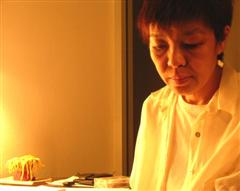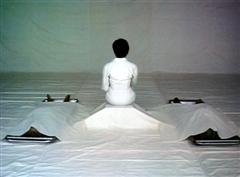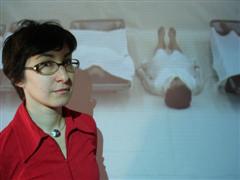|
|
A Thai in the Dead Center of Venice
|
Published in Bangkok Metro
Magazine - September 2005
|
Araya Rasdjarmrearnsook Crosses Borders
at the 2005 Venice Biennale
By Oliver Benjamin
 It’s pretty hard to unsettle people with art nowadays. Ever since Robert Mapplethorpe jumped over the frontier of the shocking by putting a crucifix in a jar of urine, artists have been stumped as to how to get under the skin of the public.
It’s pretty hard to unsettle people with art nowadays. Ever since Robert Mapplethorpe jumped over the frontier of the shocking by putting a crucifix in a jar of urine, artists have been stumped as to how to get under the skin of the public.
But criticisms of this kind of art are easy: It’s not art, some say, it’s nonsense just trying to get noticed. Of course, the same thing was said about Dali’s surrealism and Picasso’s cubism and now they’re part of the accepted artistic canon. But there is some validity to the outrage. One of Art’s greatest virtues is that it can be philosophy-in-action, forcing us to re-examine our own thoughts about the world. Though his images may have been beautiful, many are unable to find much applicable inspiration in the scatological investigations of Mapplethorpe and others like him.
As most of the humanities during the last fifty years have been plagued by the legacy of deconstructionism, the final frontier of art has been necessarily seen to be that of shock and meaninglessness. In tearing apart the conceits of western civilization, many modern artists aim to uncover our unconscious webs of illusion and reveal the naked gristle underneath. Which leads many to sigh, “Okay. And then what?”
At this year’s famed Venice Biennale, a gifted Thai artist from Chiang Mai has taken an angle on the greatest “And then what?” of all: Death. By employing actual human corpses in her works, Araya Rasdjarmrearnsook has induced the death-averse occident to take a salutary examination of their own greatest fear. And in doing so, she has shown that art need not “tear things apart” to shed light on our illusions. Indeed, it can be controversial, disturbing and morbid while at the same time beautiful, inspiring and compassionate.
Her project is part of a joint-exhibit at the Biennale with the late Montien Boonma entitled, “Those dying wishing to stay, those living preparing to  leave.” While Boonma employed elements taken from traditional Thai culture in his works, Rasdjarmrearnsook’s use of fresh corpses necessitated that she use that most modern of devices, the video camera. leave.” While Boonma employed elements taken from traditional Thai culture in his works, Rasdjarmrearnsook’s use of fresh corpses necessitated that she use that most modern of devices, the video camera.
Her series of black and white video installations feature herself and an array of sheet-covered corpses laid out on the floor before her, only the tops of their heads and their feet exposed. In each of them she interacts with them differently, though all are tinged with irony. In “Death Seminar” she reads to them from the classic Thai story, the Inao – a heroic tale of life, love and libido. In “The Class” she holds an intentionally humorous classroom “discussion,” in which she instructs the dead about death itself. In “Conversations I, II and III” she wanders among them without saying a word.
The effect of all this is both creepy and exhilarating, as if some kind of outdated taboo has been broken. The thin, temporary line between the dead and the living may have never been mapped out so clearly as in these short videos.
In the simplest, yet most haunting installation, “This is Our Creations,” Araya finally lays herself down among the corpses and recites the following poem: “I came here to know you, lying here motionless. Once my father sent me a postcard from very far away. Its sentence: only a still pond can reflect the stars.” One is impelled to wonder at the title. Here the lines between life, death and art seem blurred. It seems Araya is encouraging us to reconsider their interrelationship. And while this might be easy for a Buddhist, one doesn’t have to believe in reincarnation to get the message. Death transcends belief-systems. Without death there can be no life. And as Hegel’s dialectical theory would suggest, great art should be an attempt to reconcile the incongruent.
The response to her work has been positive overall, though a few react in horror once they realize that the corpses are real. Death has always been much harder to confront for the West than the East and it shows. Alexandra Fogel, 68, from Germany has tears in her eyes as she watches “The Class,” in which Araya teaches the dead about death. The piece is meant to be, among other things, a subtle parody on academia, but for Alexandra, who lost her husband six years ago, it’s something else altogether. “She is very brave,” whispers the elderly German. “It is very sad.”
 The exhibit is presided over by Anna Paola Passarini, a young Venetian artist who helps explain the exhibits to those who don’t exactly understand what they are seeing. More importantly, she translates for monolingual Italians; though we are in one of the greatest cities in Italy, all the signage has been done exclusively in English, an oversight that prevents the majority of visitors from fully enjoying the works. The exhibit is presided over by Anna Paola Passarini, a young Venetian artist who helps explain the exhibits to those who don’t exactly understand what they are seeing. More importantly, she translates for monolingual Italians; though we are in one of the greatest cities in Italy, all the signage has been done exclusively in English, an oversight that prevents the majority of visitors from fully enjoying the works.
When asked what the response has been to the exhibit Passarini suggests I examine the guest book. Indeed, the visitors’ outpouring of praise seems almost cathartic, as if Rasdjarmrearnsook has not only touched a nerve but cleansed it too. The exhibit has even inspired Passarini in her own art – the irony of teaching the dead about death has impelled her to inject the same playful joke into a project she is working on: an exhibit instructing Italians how to be self-confident.
It seems to me that Araya’s satire cuts to the heart of all our artistic traditions. As physicist Paul Dirac put it: “In science one tries to tell people, in such a way as to be understood by everyone, something that no one ever knew before. But in poetry, it’s the exact opposite.” So artists don’t tell us anything new, they only help us examine what we already know from oblique angles. Which is why death seems a long-overdue subject for art: It is the one thing we all know for sure: someday we will die. As the saying goes, “Nothing is certain except death and taxes.” But it’s impossible to make interesting art about taxes.
I imagine it must be depressing to be around this heavy stuff all day. Passarini assures me it is not. “I don’t feel Araya's work macabre,” she says, “It talks more about relationships, difficulties in separating from someone, feeling distance with someone that is physically present, beside you.” Spending six hours a day here in the calm and shadow, she has started to feel a guardian and interpreter for the art much the same way Araya acts as a guardian and interpreter for the dead. “It is like conversing with dead people: In artwork there's always something unsaid, unspoken, that you discover just staying for a long time with them in silence.”
I tell the young docent that it’s a shame more Thais aren’t here to see their culture represented abroad. But she assures me there’s a significant Thai population in Venice and that many have been by to see the exhibit. “But I haven’t seen a single Thai restaurant,” I protest, somewhat lamely. Passarini just shrugs and says that Venetians are too much in love with their own cuisine to care much about those of other countries. Having eaten here for a week, I can sympathize somewhat. It is the world’s good fortune, however, that they don’t feel the same way about art: The Biennale is probably the most famous and celebrated international meeting of artists on the planet.
Thailand only started participating at the previous Biennale, two years ago, but it seems they are in it for the long haul. Though it may be expensive to participate in the festival, it’s an effective, high-profile element of the Thai government’s plan to more aggressively promote Thailand’s image overseas. Choosing art as a vehicle makes sense: Thailand has long been associated with aesthetic beauty and has long been perceived by the West to harbor a chiaroscurist (both light and dark) exoticism that marries well with the visual arts.
In the case of Rasdjarmrearnsook’s exhibit, of course, it is the dark that seems to have taken the upper hand. And yet, on closer examination, those bright video screens shining in the darkness of the old Italian monastery where the exhibit is located actually tell a different story: By presenting the dead to the world with compassion and dignity, rather than the grisly horror of common news reports and violent films, she has shown us that death need not be something to recoil from. For Thais, who often keep their dead in situ for a week before cremation, this may be no great revelation, but for Westerners, it is a rare insight. And since talking openly about death continues to be an enduring taboo in the West, it is an insight that can best be proffered through the iconoclastic medium of modern art. It is Rasdjarmrearnsook’s gift, and our boon, that she has managed to inject such compassion and grace into a field that has become increasingly cold and stark. In “getting to know” the dead, she induces both artists and audience to love the objects of “our creations,” to see in their darker shadows a little more of ourselves. compassion and grace into a field that has become increasingly cold and stark. In “getting to know” the dead, she induces both artists and audience to love the objects of “our creations,” to see in their darker shadows a little more of ourselves.
I leave the dim, quiet cloister and venture back into the sound and light of bustling, tourist-ridden Venice, where I realize suddenly that there could be no better location for an exhibit like this. As Thomas Mann suggested in Death in Venice, the city is truly a museum of death: an empty shell of history kept alive by swarms of itinerant voyeurs. And what a joyous and beautiful corpse she is.
Yet someday this corpse will be buried as well. Despite frantic attempts to intervene, Venice is built on a marsh that is sinking irreversibly into the sea. Nonetheless, we can be sure that our descendants will continue to eulogize her with a vast array of images and words, our only hedge against death, our art.
Note to self: Buy plenty of postcards.
|
|
|
|
All text and images © copyright Oliver Benjamin |
|
|
|
|

